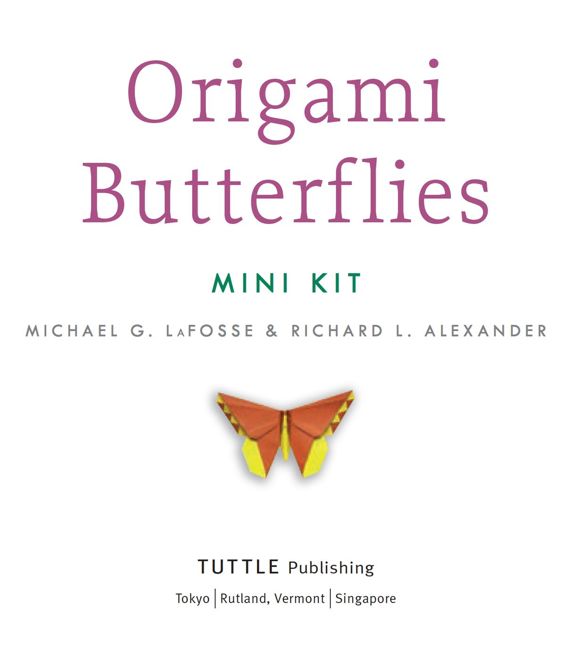
The Tuttle Story
Books to Span the East and West Most people are surprised to learn that the worldslargest publisher of books on Asia had its humblebeginnings in the tiny American state of Vermont.The companys founder, Charles E. Tuttle, belongedto a New England family steeped in publishing.And his first love was naturally booksespeciallyold and rare editions. Immediately after WW II, serving in Tokyo underGeneral Douglas MacArthur, Tuttle was taskedwith reviving the Japanese publishing industry.He later founded the Charles E. Tuttle PublishingCompany, which thrives today as one of theworlds leading independent publishers. Though a westerner, Tuttle was hugely instrumentalin bringing a knowledge of Japan and Asiato a world hungry for information about the East.By the time of his death in 1993, Tuttle had publishedover 6,000 books on Asian culture, historyand arta legacy honored by the Japanese emperorwith the Order of the Sacred Treasure, the highesttribute Japan can bestow upon a non-Japanese. With a backlist of 1,500 titles, Tuttle Publishingis more active today than at any time in its pastinspired by Charles Tuttles core mission topublish fine books to span the East and West andprovide a greater understanding of each.
Published by Tuttle Publishing, an imprint of Periplus Editions(HK) Ltd. www.tuttlepublishing.com Copyright 2013 by Michael G. LaFosse and Richard L. Alexander All rights reserved. No part of this publication may be reproducedor utilized in any form or by any means, electronic or mechanical,including photocopying, recording, or by any informationstorage and retrieval system, without prior written permissionfrom the publisher. The origami models in this book may not be used for commercialpurposes without written permission from the authors.
ISBN: 978-4-8053-1278-0
ISBN: 978-1-4629-1731-0 (ebook) Distributed by: North America, Latin America & Europe
Tuttle Publishing
364 Innovation Drive
North Clarendon, VT 05759-9436 U.S.A.
Tel: 1 (802) 773-8930; Fax: 1 (802) 773-6993
Email: Japan
Tuttle Publishing
Yaekari Building, 3rd Floor
5-4-12 Osaki, Shinagawa-ku,
Tokyo 141 0032
Tel: (81) 3 5437-0171; Fax: (81) 3 5437-0755
Asia Pacific
Berkeley Books Pte. Ltd.
61 Tai Seng Avenue #02-12
Singapore 534167
Tel: (65) 6280-1330; Fax: (65) 6280-6290
First edition
17 16 15 14 6 5 4 3 2 Printed in China 1312CT TUTTLE PUBLISHING is a registered trademark of TuttlePublishing, a division of Periplus Editions (HK) Ltd. Contents

 How to Download the Bonus Material of this Book.
How to Download the Bonus Material of this Book.
1. You must have an internet connection. 2. http://www.tuttlepublishing.com/origami-butterflies-mini-kit-downloadable-cd-content For support email us at . http://www.tuttlepublishing.com/origami-butterflies-mini-kit-downloadable-cd-content For support email us at .
Key to the Origami Folding Symbols Take a few moments to become familiar with these symbols and their meanings. As you watchthe , look at the corresponding diagrams in the book to reinforce your understanding. Onceyou learn this elegant diagramming system, you will be able to enjoy countless origami books. 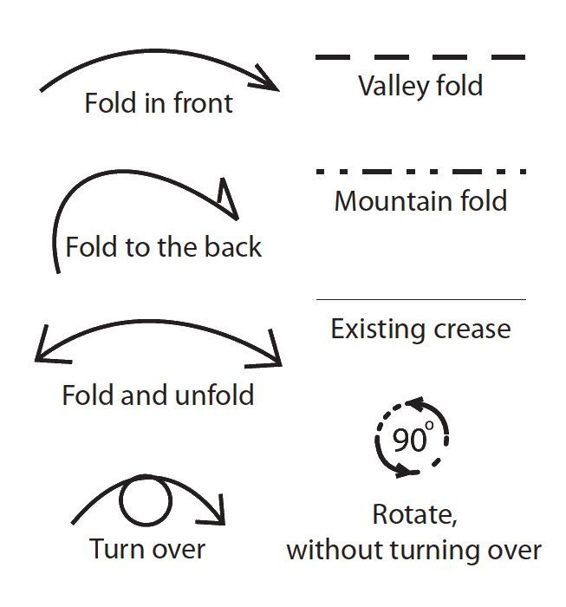
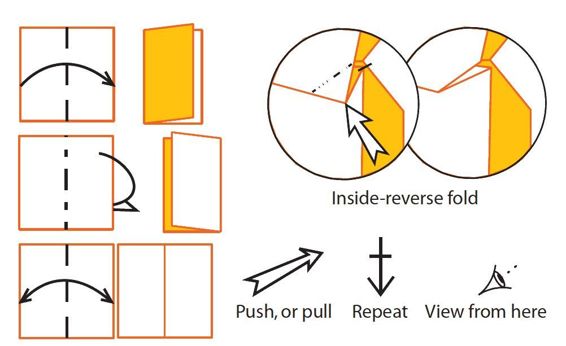

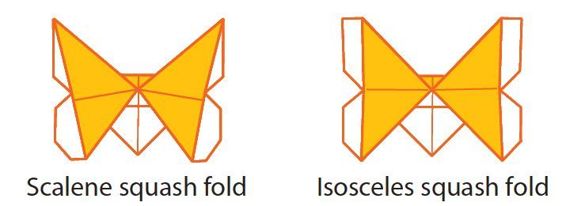 Scalene squash fold: Forms an asymmetrical trianglewith no congruent edges.
Scalene squash fold: Forms an asymmetrical trianglewith no congruent edges.
Isosceles squash fold: Forms a symmetrical trianglewith at least two congruent edges.  Introduction
Introduction
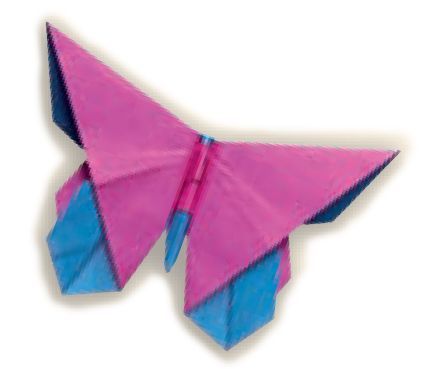 Michael LaFosse folded his first original origami butterfly whileriding a subway with Alice Gray more than 30 years ago. They hadjust left Lillian Oppenheimers Origami Center in Union Square,where Michael showed Alice his amazing origami praying mantis.Alice offered to show him around the Entomology Department at the AmericanMuseum of Natural History, so off they went.
Michael LaFosse folded his first original origami butterfly whileriding a subway with Alice Gray more than 30 years ago. They hadjust left Lillian Oppenheimers Origami Center in Union Square,where Michael showed Alice his amazing origami praying mantis.Alice offered to show him around the Entomology Department at the AmericanMuseum of Natural History, so off they went.
En route, Michael folded the first Butterfly for Alice. Encouraged, Michael began developing a system to produce a variety ofinteresting butterfly wing patterns. Years later, we attended our first origami convention in New York, where RussellCashdollar displayed sets of interesting origami butterflies. Inspired by Russells work,Michael has been developing stunning new origami butterflies ever since. Origami butterflies were part of Michaels exhibition for the Morikami Museum inFloridas Palm Beach County. The museum hosted Michael for an Artist in Residencyprogram to design and fold dozens of origami fine art renditions of animals and plantsfor a traveling exhibition to raise public awareness of Floridas hidden nature.
Most ofthe butterflies in this kit are named to honor the contributions of Morikami personnel.To view some of Michaels art made from my handmade Origamido paper, please visitwww.origamido.com. We hope you enjoy the original origami butterfly designs presented in this kit! Origamido Studio
Richard Alexander A Butterfly for George Morikami 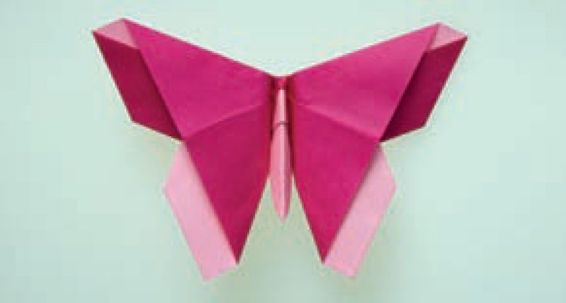 George Morikami came to the U.S. as a teenager in 1906to join the Yamato Colony, a community of Japanesefarmers in Florida. Morikami bought land in BocaRaton and Delray Beach, which he farmed for decades.Through his generosity, this land became the MorikamiMuseum and Japanese Gardens, where Michael hastaught paper making and folding on several occasions.
George Morikami came to the U.S. as a teenager in 1906to join the Yamato Colony, a community of Japanesefarmers in Florida. Morikami bought land in BocaRaton and Delray Beach, which he farmed for decades.Through his generosity, this land became the MorikamiMuseum and Japanese Gardens, where Michael hastaught paper making and folding on several occasions. 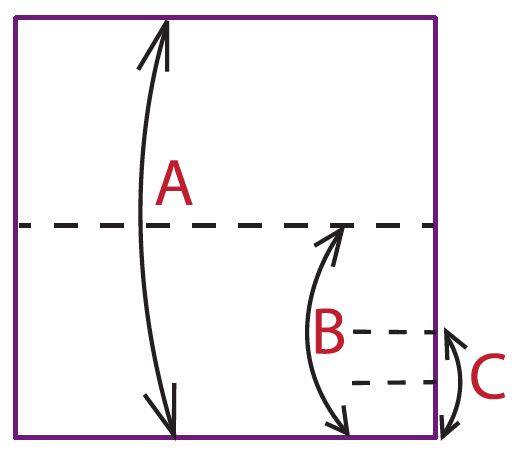 Begin with the minor colorfacing up. (B) Pinch a short valleyfold at the quarter length,aft er aligning the bottom edgeto center crease. Unfold. (C)Pinch a short valley fold at theeighth length, aft er aligningthe bottom edge to the firstpinch mark. Unfold.
Begin with the minor colorfacing up. (B) Pinch a short valleyfold at the quarter length,aft er aligning the bottom edgeto center crease. Unfold. (C)Pinch a short valley fold at theeighth length, aft er aligningthe bottom edge to the firstpinch mark. Unfold.  Lay the lower pinch markon top of the upper pinchmark and valley-fold the flaphalfway between the two pinchmarks. Unfold.
Lay the lower pinch markon top of the upper pinchmark and valley-fold the flaphalfway between the two pinchmarks. Unfold. 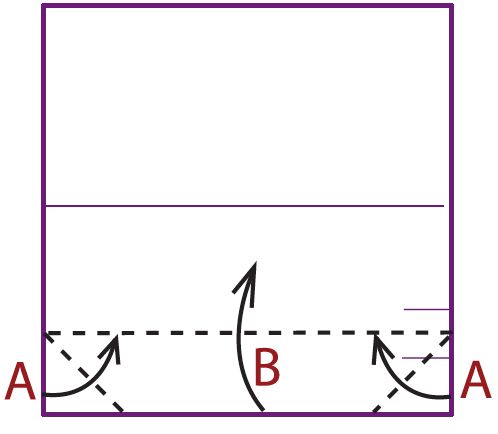 (A) Valley-fold the bottomleft and right corners to thevalley crease above. (B) Valleyfoldthe flap upward to lockthe corners inside.
(A) Valley-fold the bottomleft and right corners to thevalley crease above. (B) Valleyfoldthe flap upward to lockthe corners inside.  Turn over, bottom to top.
Turn over, bottom to top. 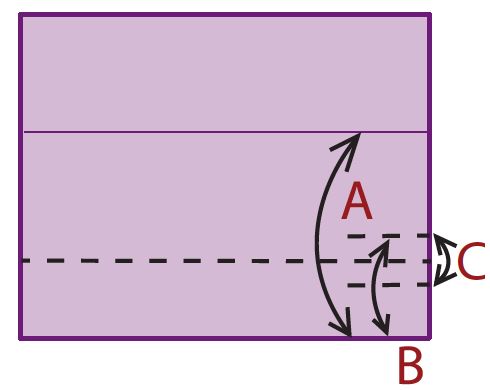
Next page
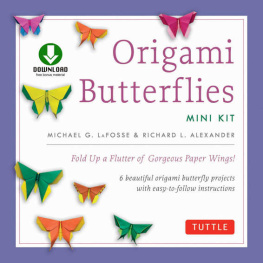
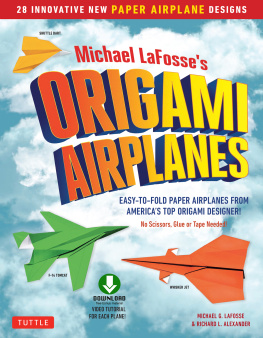
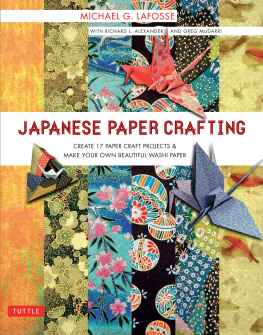
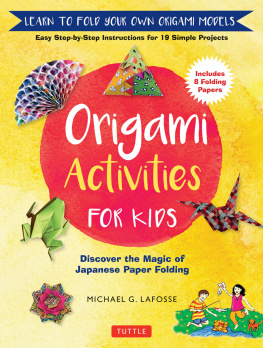



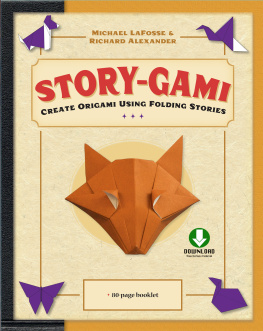

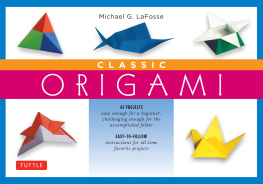
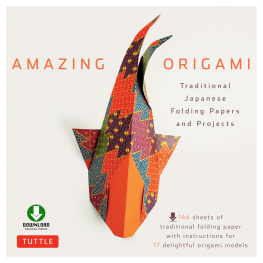
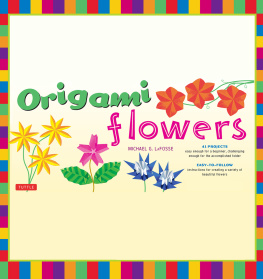
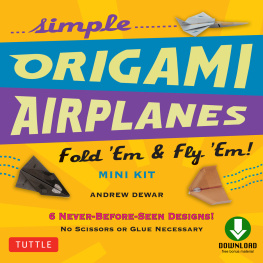
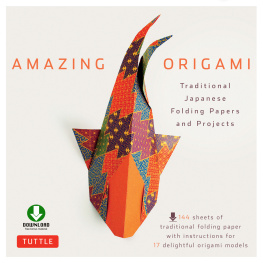
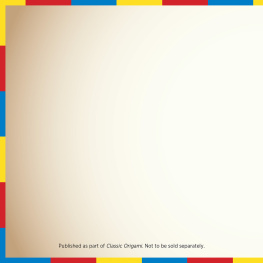
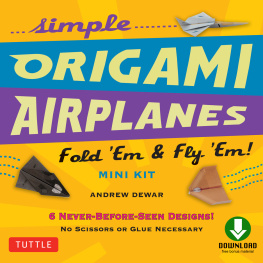
![Alexander Richard L. - Michael LaFosses Origami Butterflies: Elegant Designs from a Master Folder [Full-Color Book & Downloadable Instructional Media]](/uploads/posts/book/171883/thumbs/alexander-richard-l-michael-lafosse-s-origami.jpg)



 How to Download the Bonus Material of this Book.
How to Download the Bonus Material of this Book.


 Scalene squash fold: Forms an asymmetrical trianglewith no congruent edges.
Scalene squash fold: Forms an asymmetrical trianglewith no congruent edges. Introduction
Introduction Michael LaFosse folded his first original origami butterfly whileriding a subway with Alice Gray more than 30 years ago. They hadjust left Lillian Oppenheimers Origami Center in Union Square,where Michael showed Alice his amazing origami praying mantis.Alice offered to show him around the Entomology Department at the AmericanMuseum of Natural History, so off they went.
Michael LaFosse folded his first original origami butterfly whileriding a subway with Alice Gray more than 30 years ago. They hadjust left Lillian Oppenheimers Origami Center in Union Square,where Michael showed Alice his amazing origami praying mantis.Alice offered to show him around the Entomology Department at the AmericanMuseum of Natural History, so off they went. George Morikami came to the U.S. as a teenager in 1906to join the Yamato Colony, a community of Japanesefarmers in Florida. Morikami bought land in BocaRaton and Delray Beach, which he farmed for decades.Through his generosity, this land became the MorikamiMuseum and Japanese Gardens, where Michael hastaught paper making and folding on several occasions.
George Morikami came to the U.S. as a teenager in 1906to join the Yamato Colony, a community of Japanesefarmers in Florida. Morikami bought land in BocaRaton and Delray Beach, which he farmed for decades.Through his generosity, this land became the MorikamiMuseum and Japanese Gardens, where Michael hastaught paper making and folding on several occasions.  Begin with the minor colorfacing up. (B) Pinch a short valleyfold at the quarter length,aft er aligning the bottom edgeto center crease. Unfold. (C)Pinch a short valley fold at theeighth length, aft er aligningthe bottom edge to the firstpinch mark. Unfold.
Begin with the minor colorfacing up. (B) Pinch a short valleyfold at the quarter length,aft er aligning the bottom edgeto center crease. Unfold. (C)Pinch a short valley fold at theeighth length, aft er aligningthe bottom edge to the firstpinch mark. Unfold.  Lay the lower pinch markon top of the upper pinchmark and valley-fold the flaphalfway between the two pinchmarks. Unfold.
Lay the lower pinch markon top of the upper pinchmark and valley-fold the flaphalfway between the two pinchmarks. Unfold.  (A) Valley-fold the bottomleft and right corners to thevalley crease above. (B) Valleyfoldthe flap upward to lockthe corners inside.
(A) Valley-fold the bottomleft and right corners to thevalley crease above. (B) Valleyfoldthe flap upward to lockthe corners inside.  Turn over, bottom to top.
Turn over, bottom to top. 